Camping at Dryandra Woodland NP

At the start of November, my partner and I went on a camping trip to Dryandra Woodland National Park. We had many wildlife encounters throughout our stay over 3 nights. I of course brought along my nature journaling gear to record all the adventures and will share my pages and stories below. Read on to find out what makes Dryandra Woodland a unique habitat for many different species and the encounters we had.
Jump to a section below or watch the adventure on YouTube:
Monday 7th November
Tuesday 8th November
Wednesday 9th November
Thursday 10th November
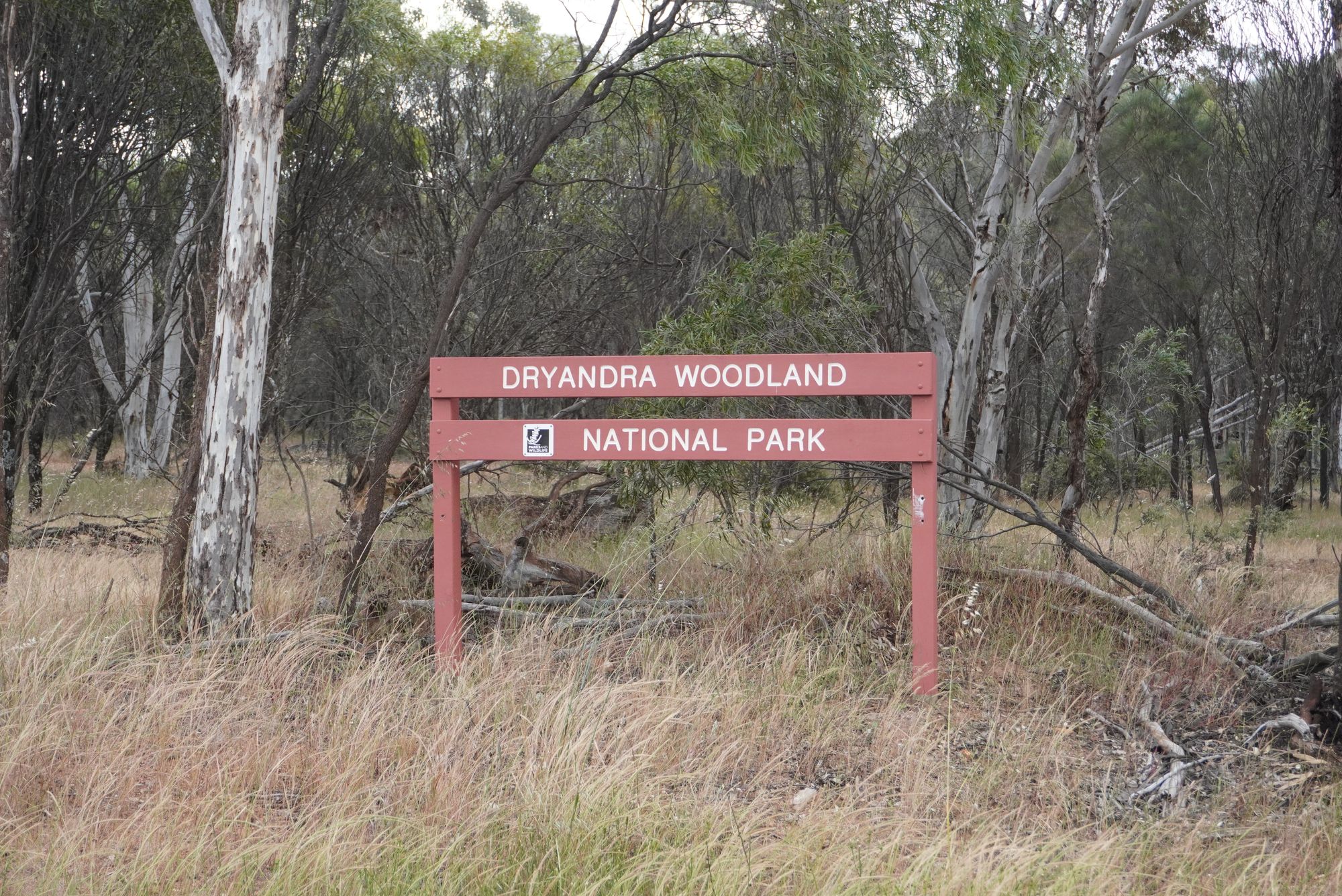
A new national park
Dryandra Woodland was recently given national park status, helping to further protect this special pocket of remnant woodland on the western edge of the Golden Outback in Western Australia. The native vegetation includes tall eucalypts, white-barked wandoo and some sandalwood, all important to the conservation of this biodiverse area.
Within the boundaries of the 28 000 hectares of preserved bush is Barna Mia, a sanctuary for native animals facing extinction. These include the bilby, woylie, mala, quenda and boodie. Here they can continue to live in their natural setting, safe from predators such as feral cats and foxes. Sadly most of these native mammals have been eradicated from their former habitats not only due to predation but also because of land clearing and changed fire regimes.
Unfortunately, we were unable to book in for the Barna Mia nocturnal wildlife tour while we were in Dryandra, but we still had a fantastic experience nonetheless (and a good reason to return another day).
Monday 7th November
Meeting the welcome echidna and nocturnal woylies
We left after lunch, driving for 2 hours from Mandurah, to set up our tent at Congelin Campground. Just a few hundred metres within the park boundary we were greeted by our so-called "welcome" echidna. It was perched on top of a log by the side of the road and boded well for future wildlife sightings. In fact, we saw two more that afternoon!
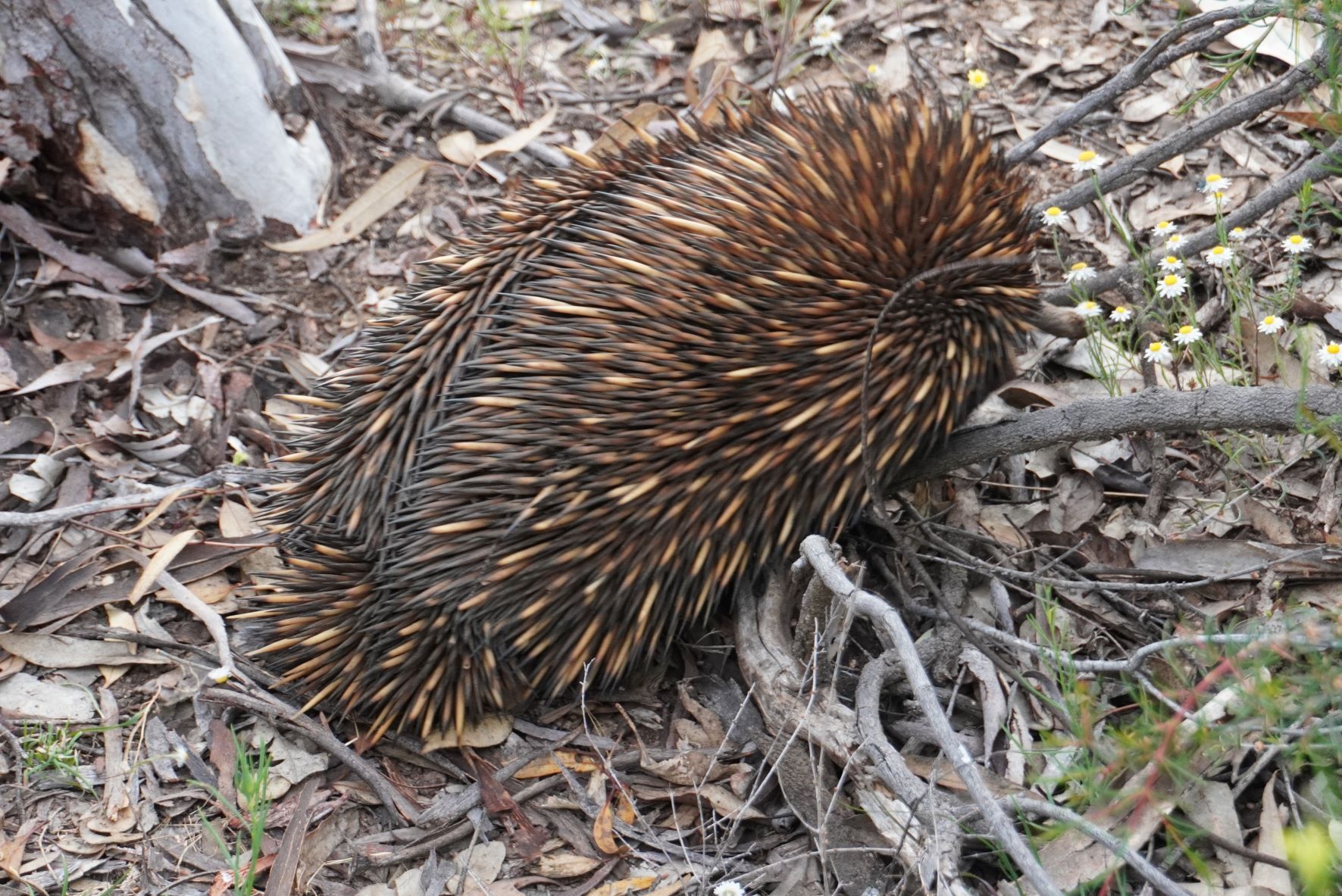
As evening fell we had a neighbouring brush-tailed possum come down a tree and check out our campsite. Other night visitors included hopping woylies, two tawny frogmouths, a far-off mopoke (Australian boobook owl) and a terrible, screeching raptor in the early hours of the morning.
The woylies were fearless and quick, running, digging and bounding through the grass around our campsite. I recall thinking they looked similar to quokkas in how they sat on their hind legs to eat but resembled hopping quendas. They have long tails with dark, bushy tips.
Woylies are important bush ecosystem engineers and evidence of their nocturnal diggings could be seen everywhere around Dryandra. By turning over the topsoil they help to spread nutrients, seeds and fungal spores as well as aerate it and facilitate water absorption.
There was a slight drizzle that night and the morning of the last day, but otherwise, the weather was fine and cool.
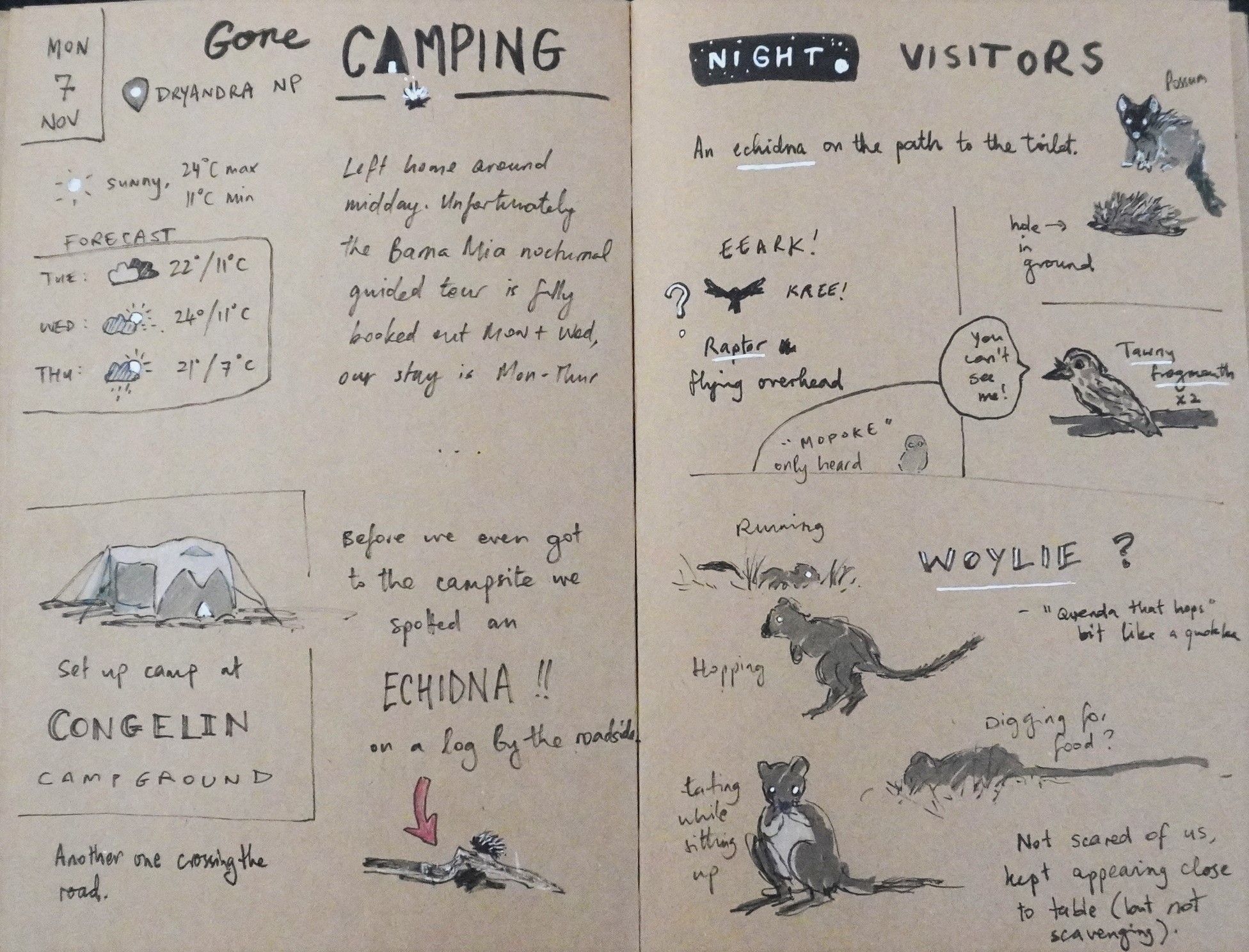
Tuesday 8th November
Commencing the hunt for numbats
Galahs kept us company at breakfast time while magpies quietly searched the grass further down the campsite. One particular bird call got us intrigued (it sounded like gears whirring to me) and eventually we identified a female red-cap robin. She was there every morning, usually in the wispy, lichen-covered trees.
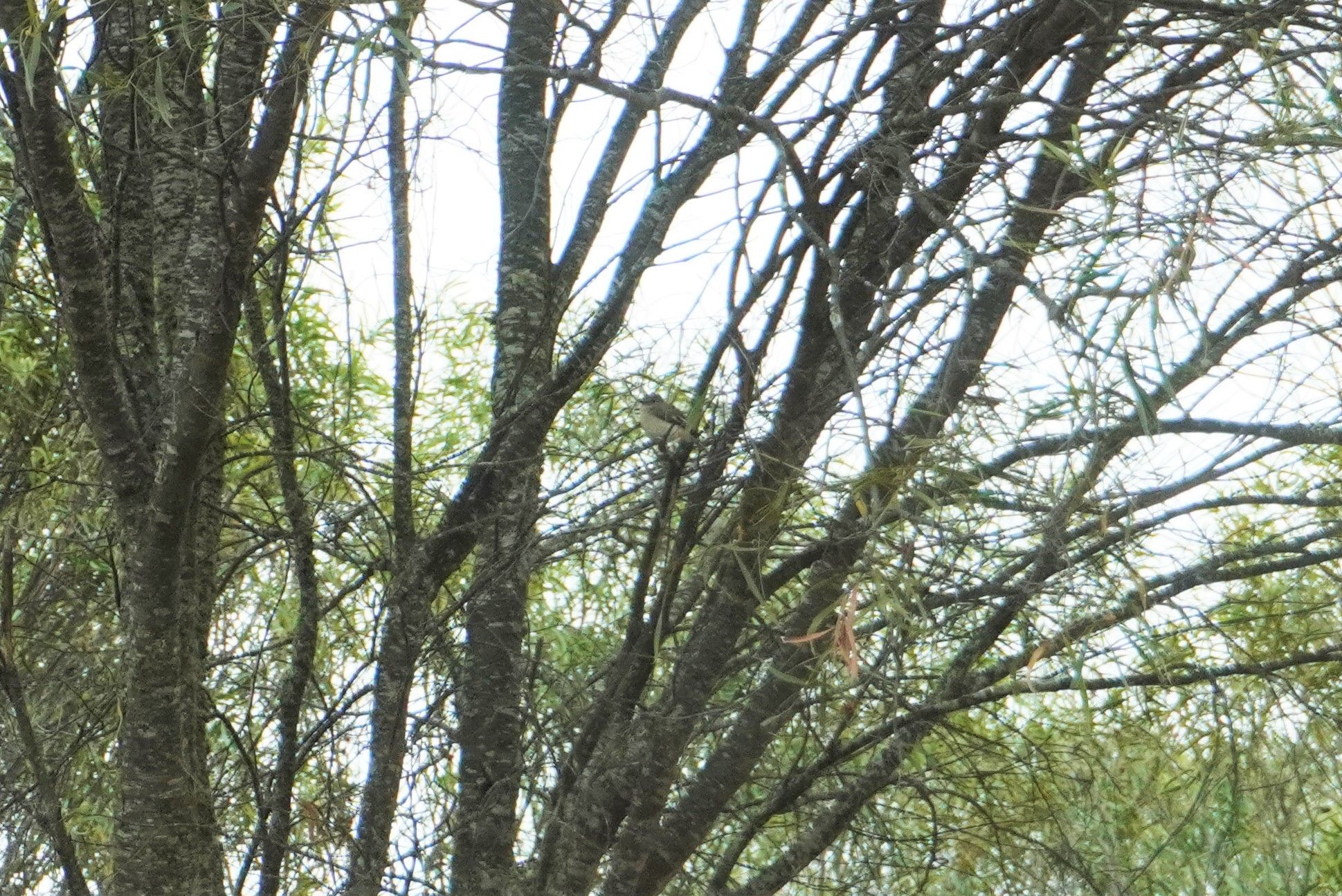
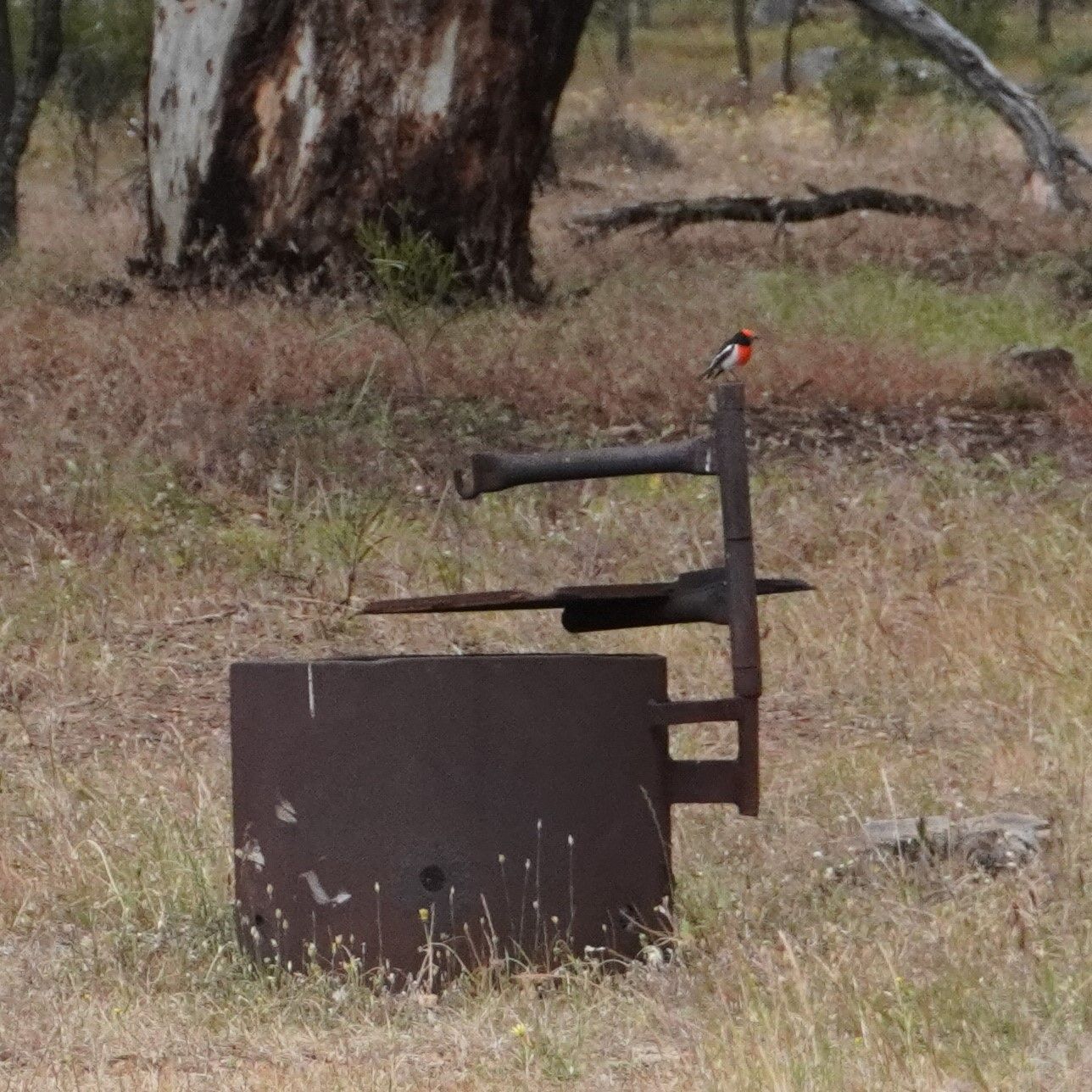
We actually spotted so many birds I filled a page with a list. However, my main goal during this camping trip was to find a numbat! So we set off in our car, driving at about 10 km/h on the various tracks through the bush, keeping our eyes peeled for some sign of the elusive creatures. The bush was incredibly beautiful too, and we stopped many times to admire the different flowers and environments we drove through.
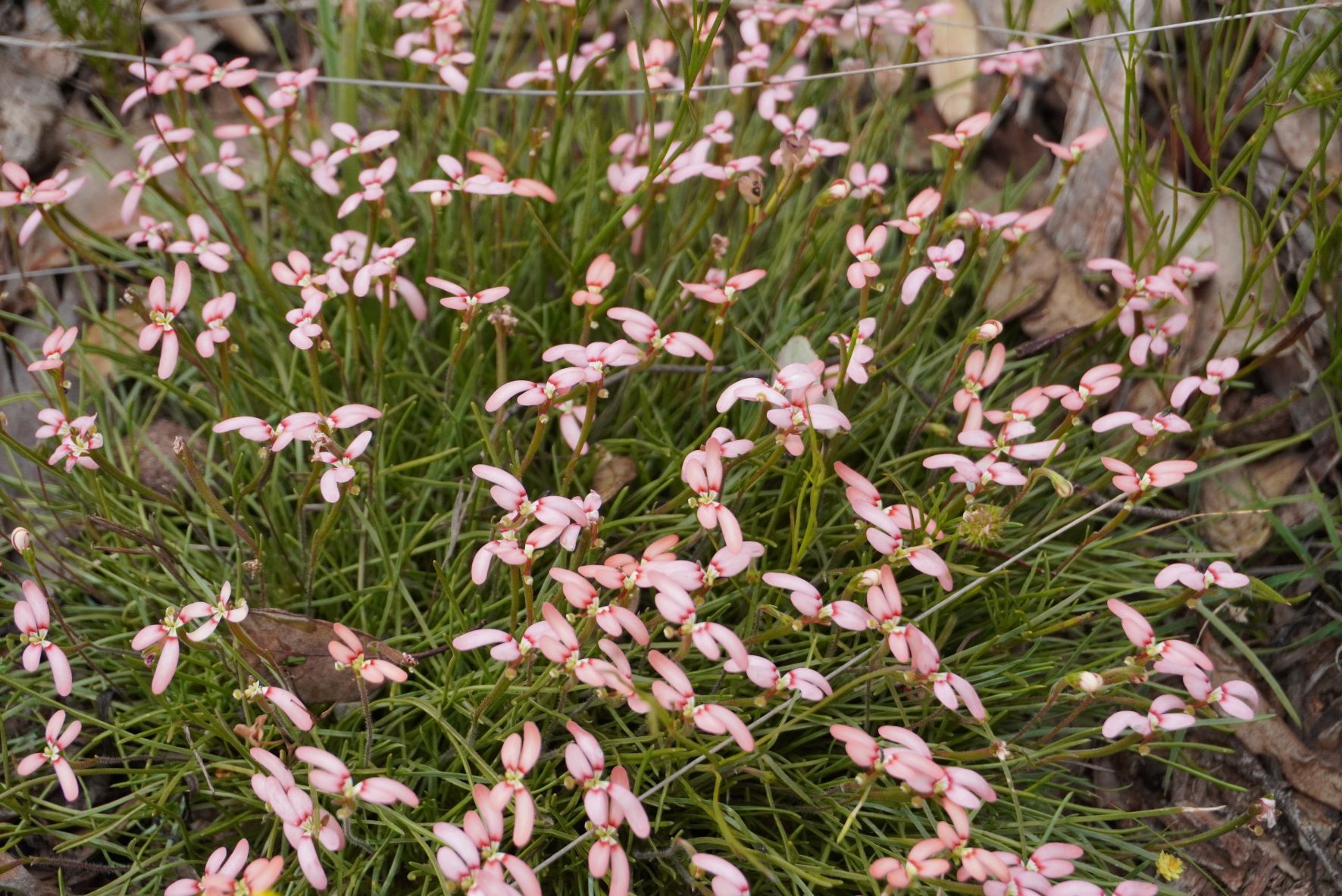
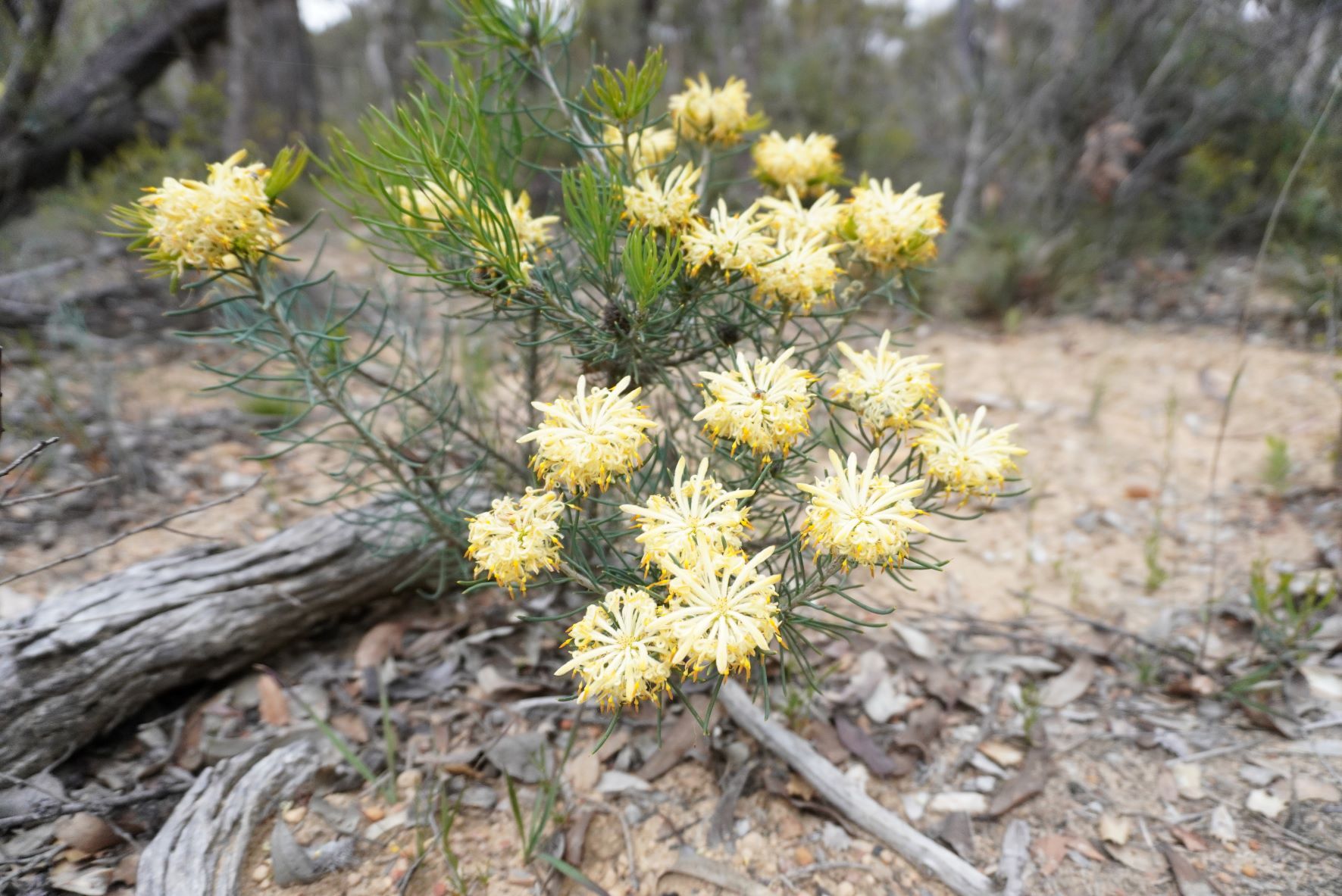
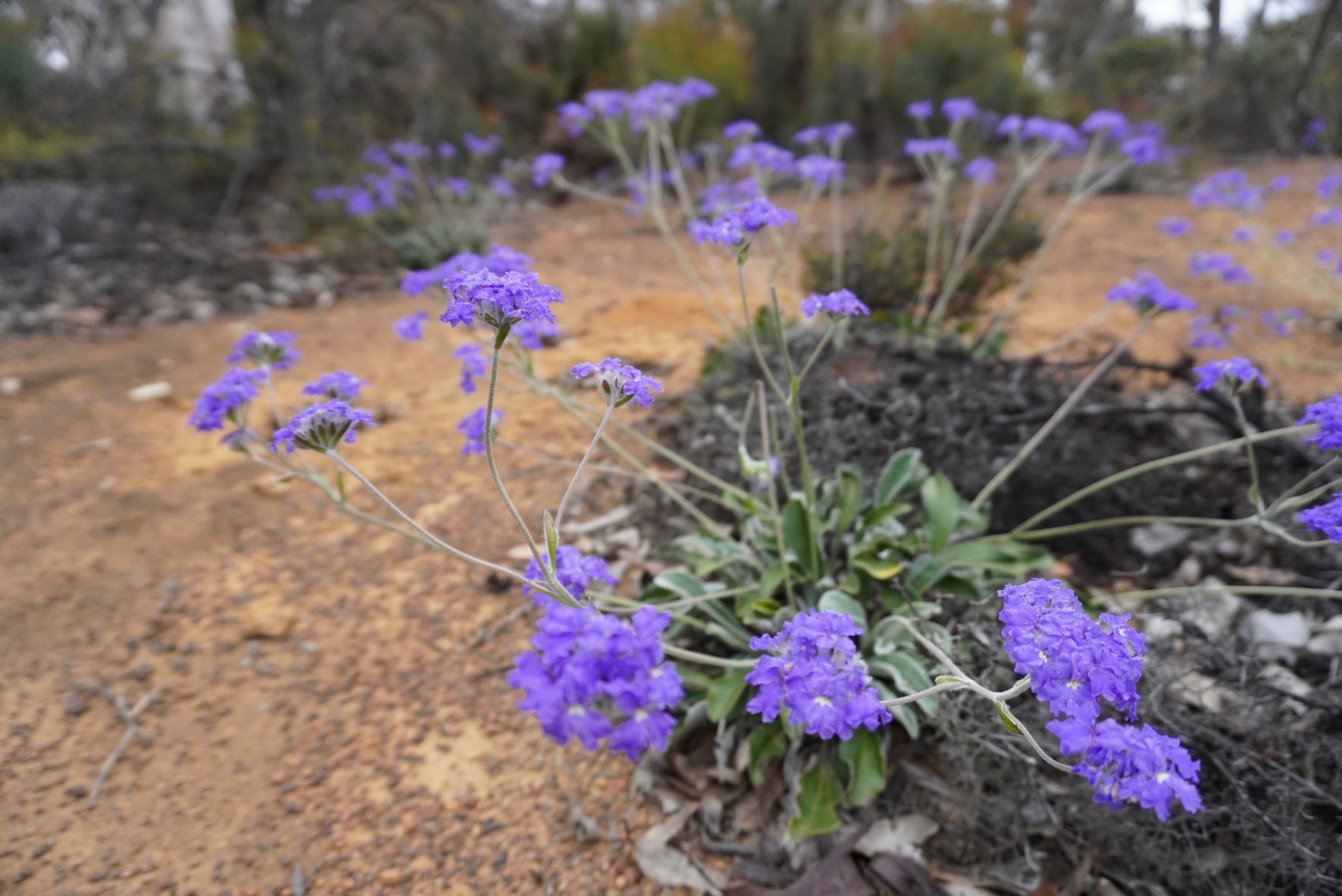
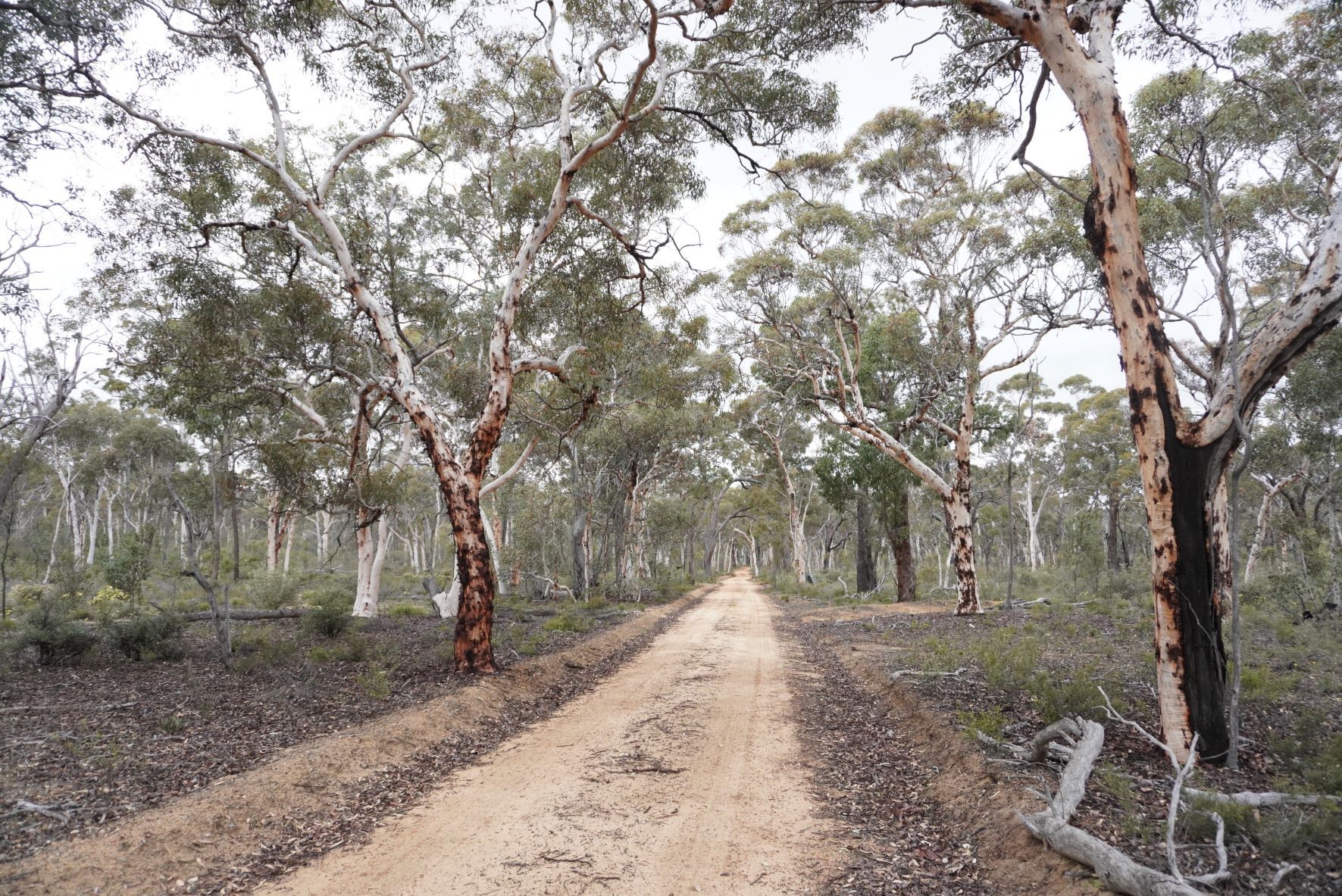
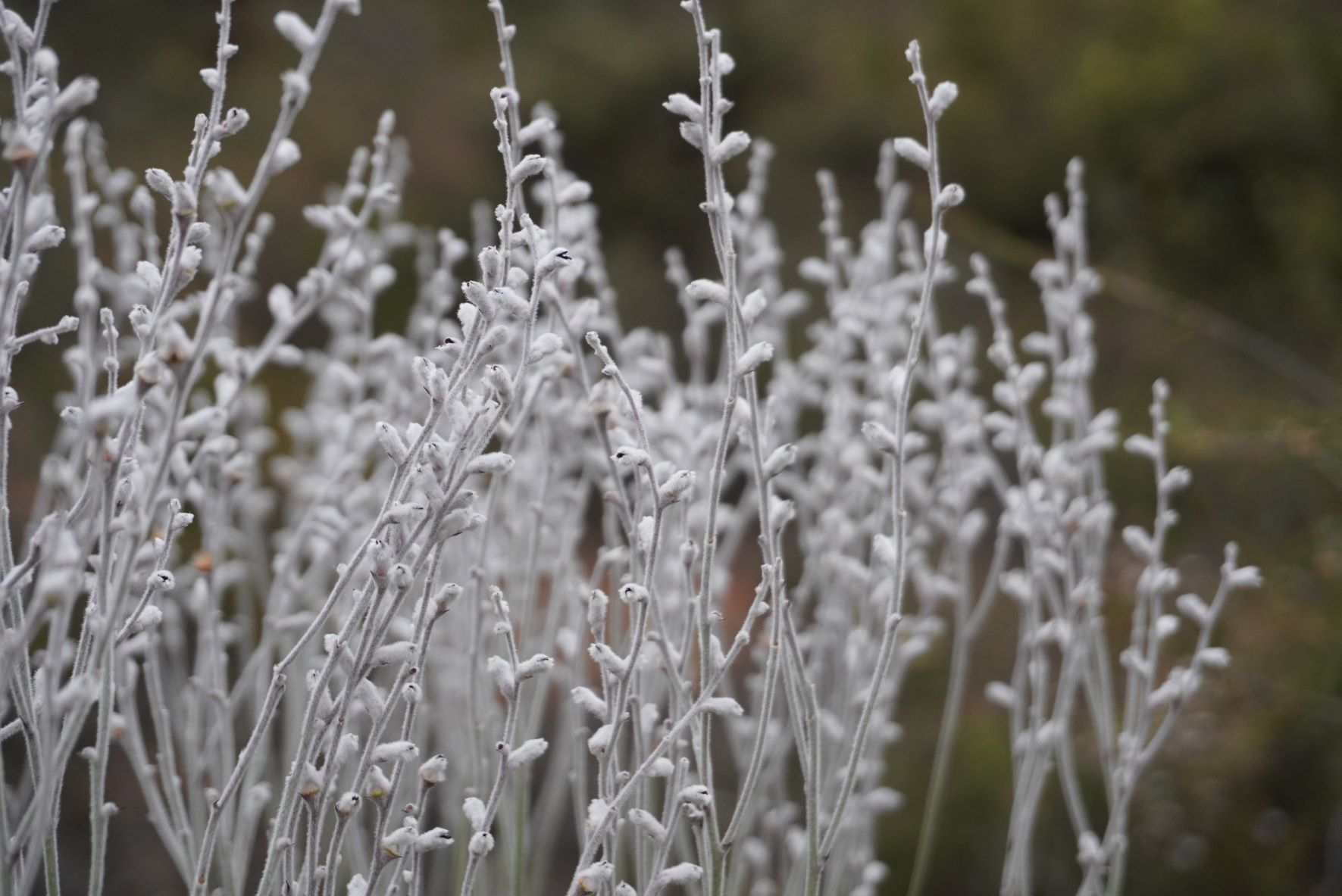
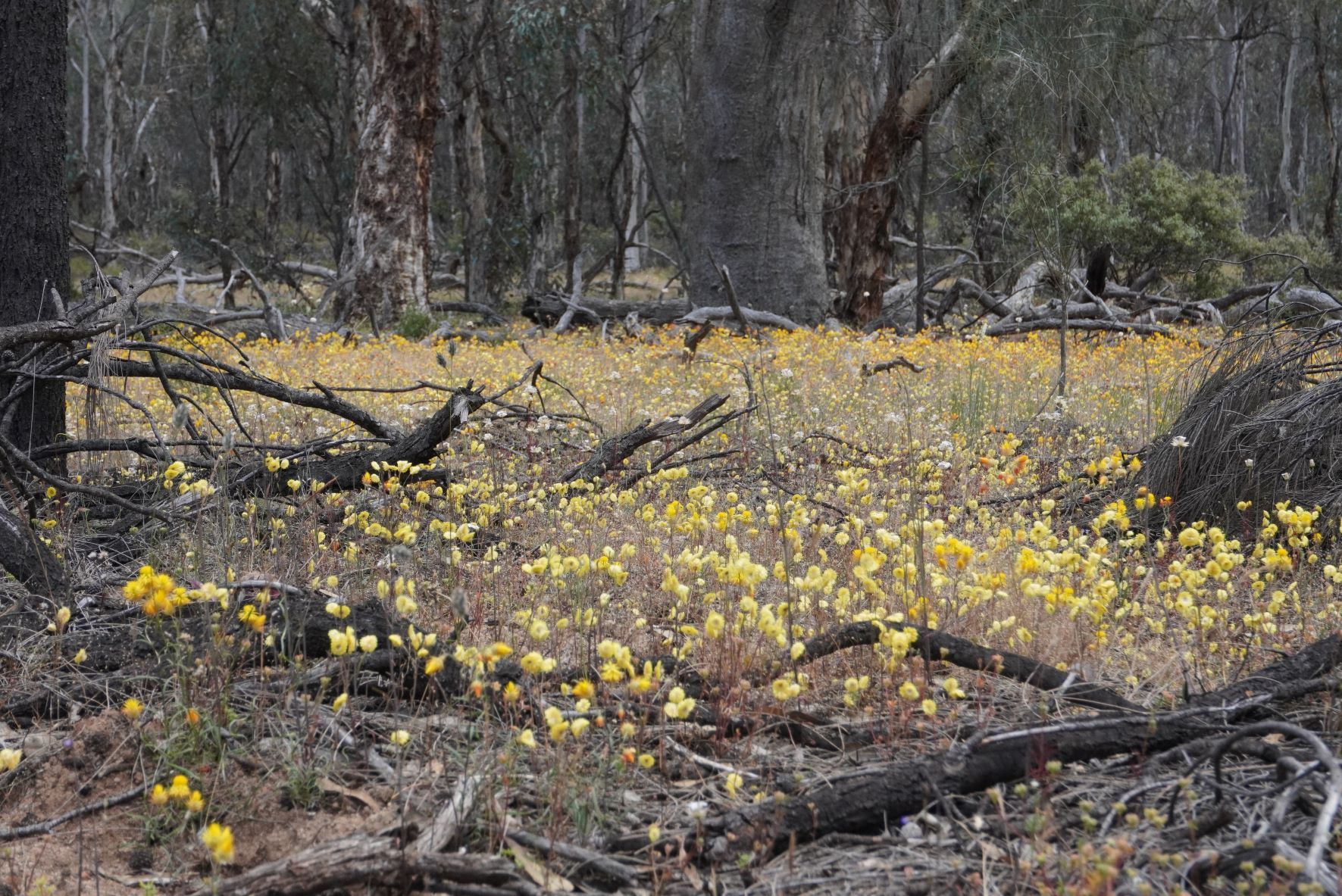
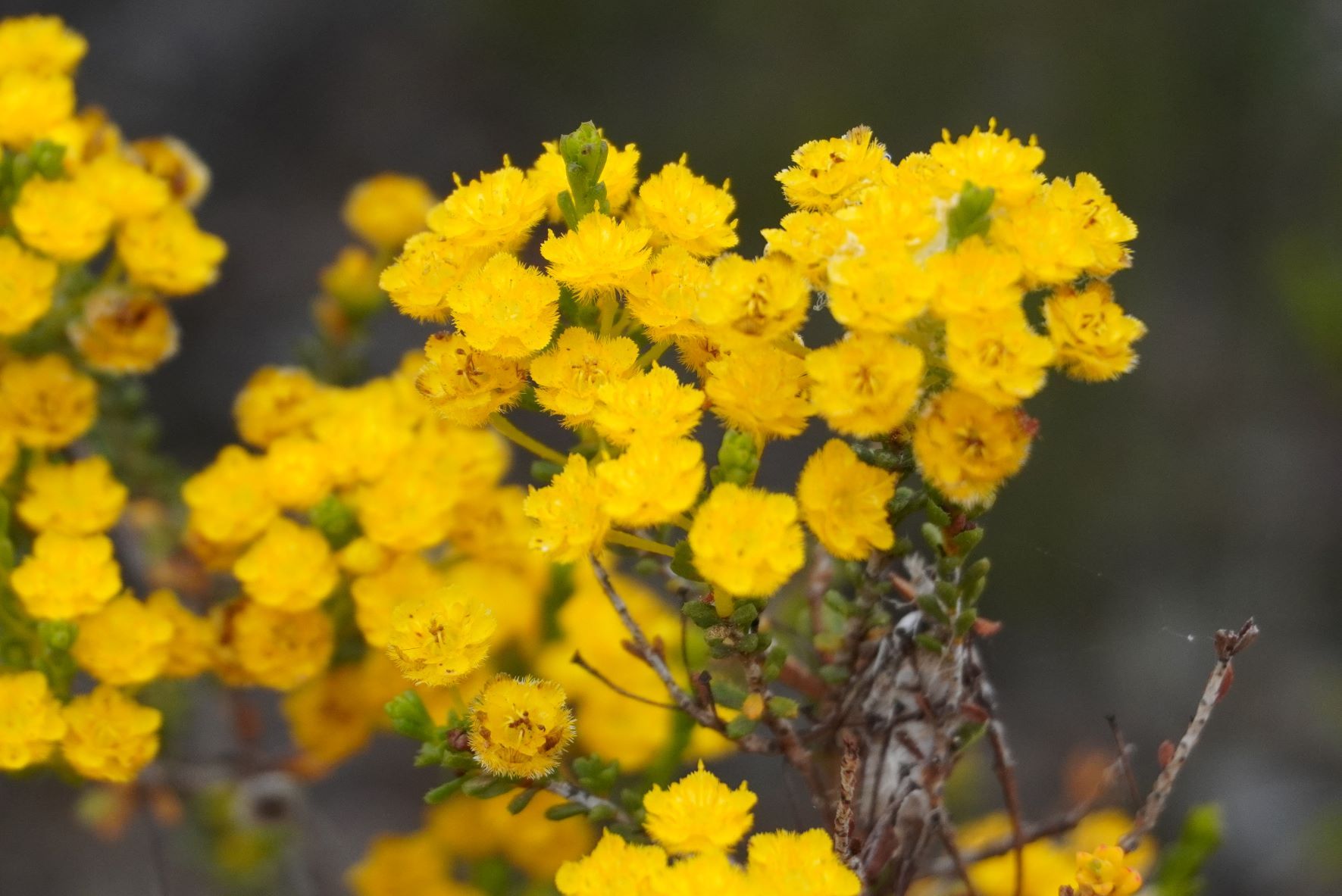
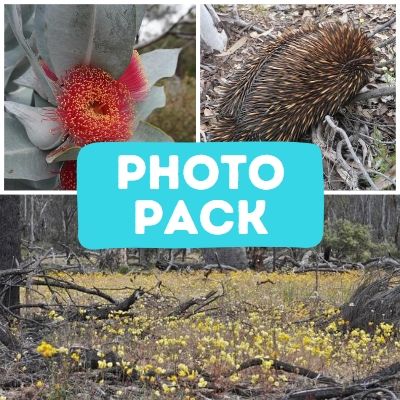
Dryandra photopack
18 photos of flora and fauna from the Dryandra Woodland NP for personal or artistic use.
It happened to also be the same time as the annual numbat survey run by Dr Tony Friend (DBCA Research associate) and volunteers of The Numbat Taskforce. Over their 380 km survey circuit, they sighted 39 numbats, an encouraging sign the population is growing. Back in 2014 the population was estimated to be only about 50 individuals so to have them spot this many spread throughout the woodlands is very promising. Would we be lucky enough to see one?
At lunchtime, with blurry eyes (from scanning the bush) we stopped at the firetower lookout near the Ochre Trail. It was a lovely spot for a view and wander. A beautiful mottlecah (Eucalyptus macrocarpa) was flowering here, but it was difficult to get a good photo as they were too high. So, when we spotted another one at the bottom of the hill in the Arboretum, we got out for another photo.
Then suddenly - a grey blur in my peripheral vision running away up the path - a furry tail perhaps? Yes, indeed it was a numbat! The female (a teenager perhaps as she was quite small) hid in a log and after we waited patiently, saw her poke her head out. Eventually, she emerged to lick some termites and sit on the log. I mentally took a lot of notes and questions while I stood behind the tree watching her, to include in my journal that evening. We then continued ambling through the Arboretum before returning to the car.
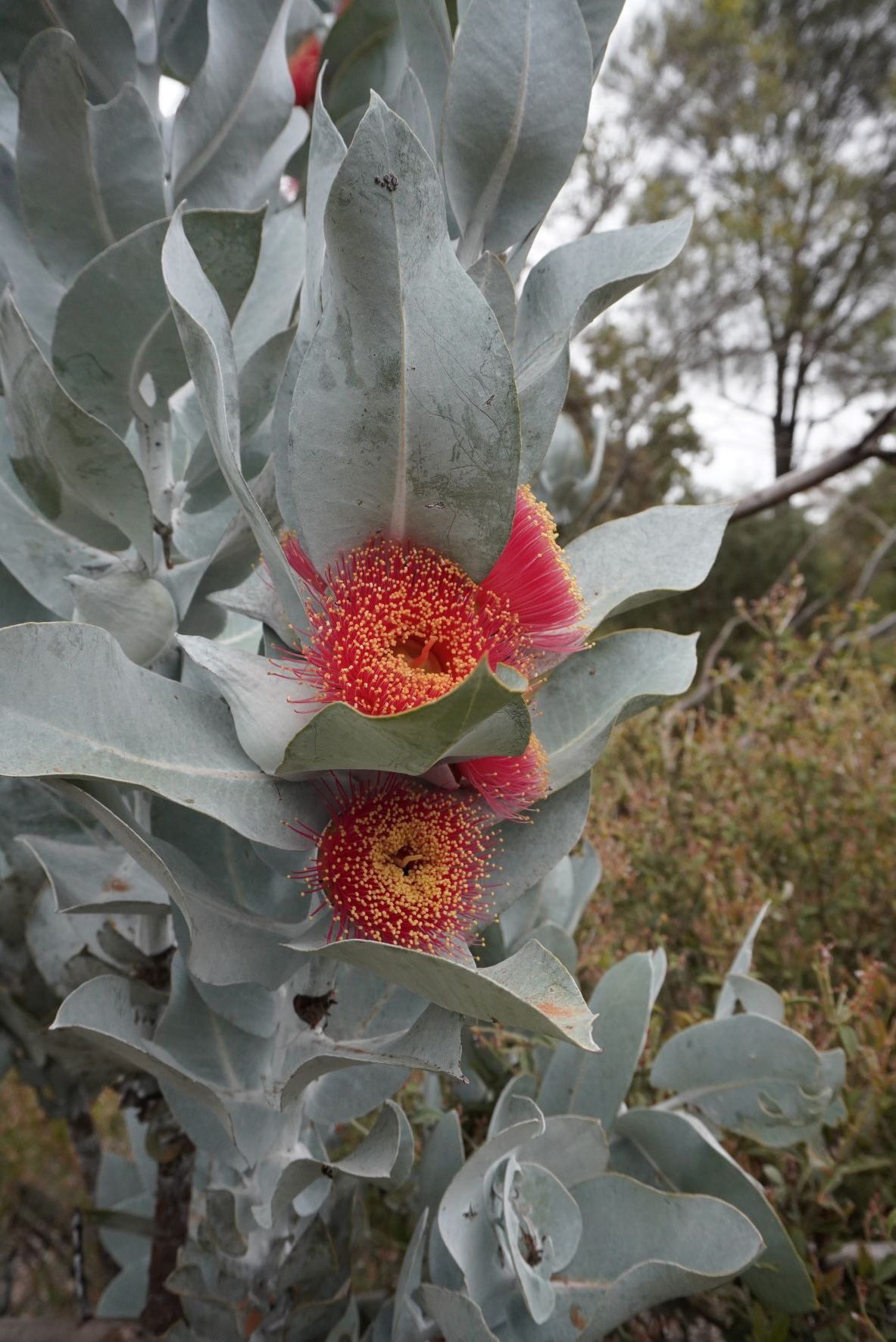
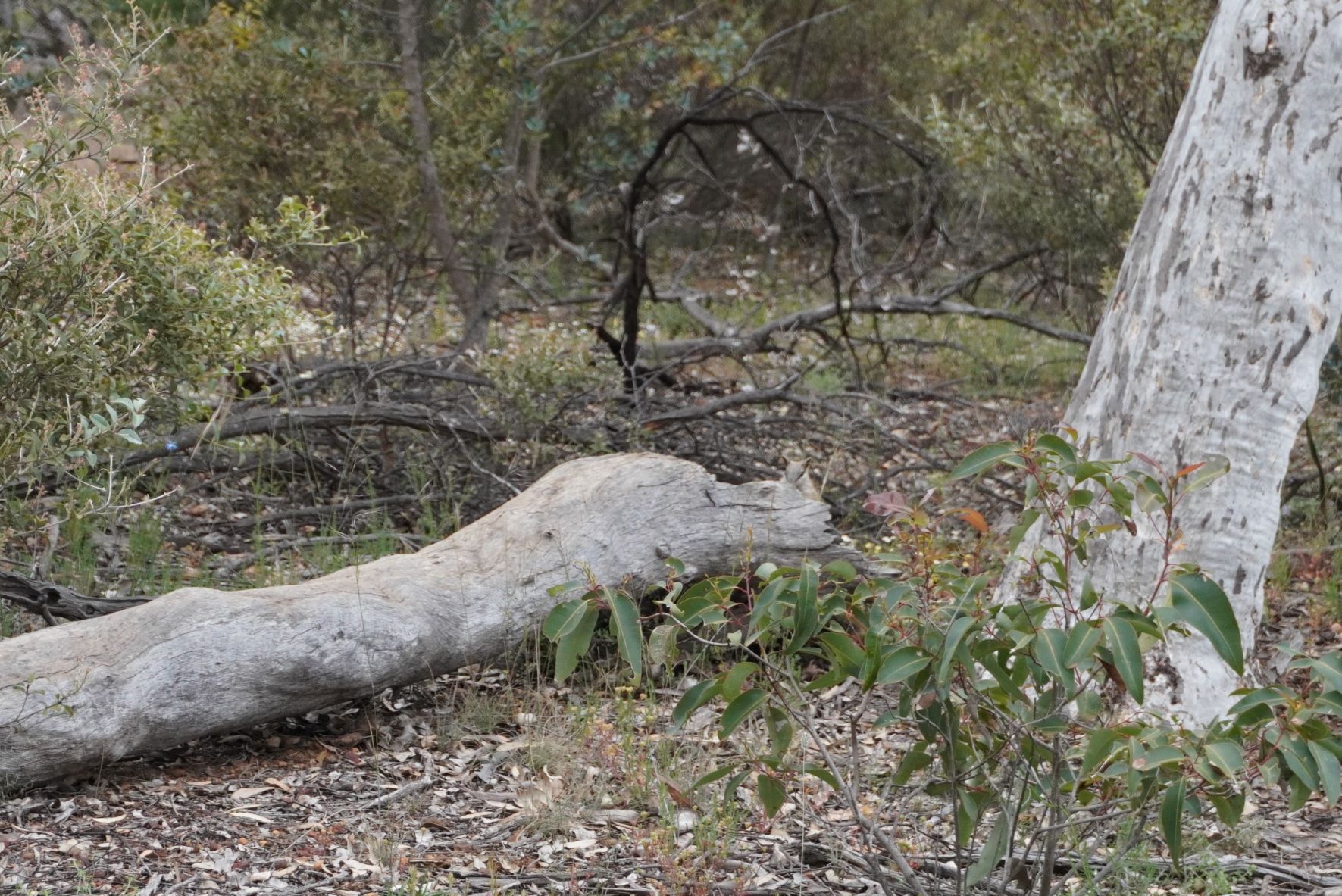

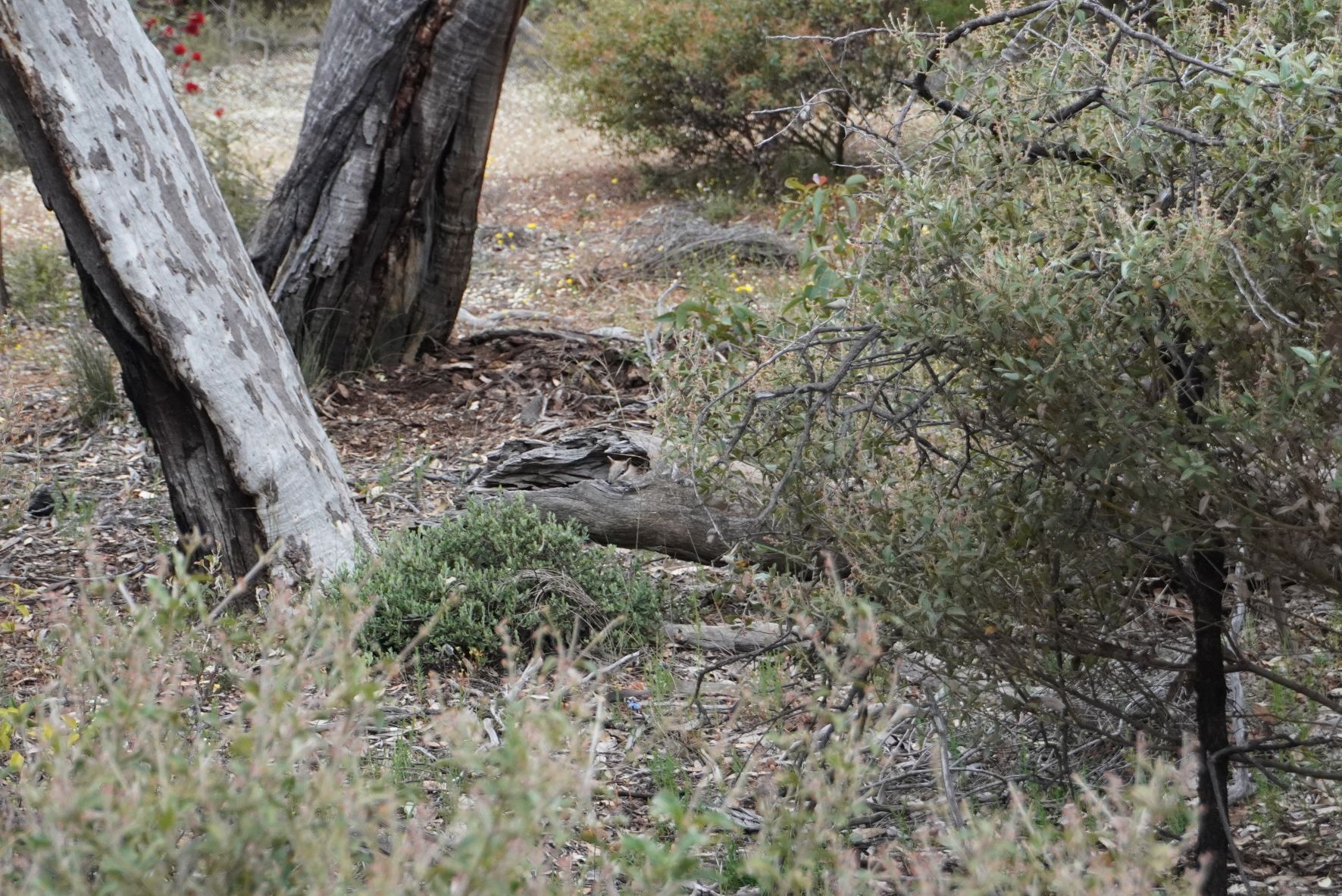
With my mission accomplished, we decided to rest our eyes and instead stretch our legs on the Woylie Walk. It's described as a walk through "woodlands of wandoo, powderbark, kwongan heathlands, jarrah and stands of rock sheoak" where you can see evidence of woylie diggings and possibly numbats. It was a lovely landscape to wander through with many birds, flowers and another echidna, but no numbats.
The signs stated the walk to be a 5.5 km loop and should take about 2 hours, however, our GPS recorded 6.4 km and it took us 2.5 hours.
That evening our night visitors returned once again while we were cooking dinner. The screeching raptor was located at the top of a nearby jarrah tree so we grabbed our binoculars and identified it as an Eastern Barn Owl. One new visitor was a pleasant surprise for us - the chuditch (Western quoll) that quickly ran off into the night.
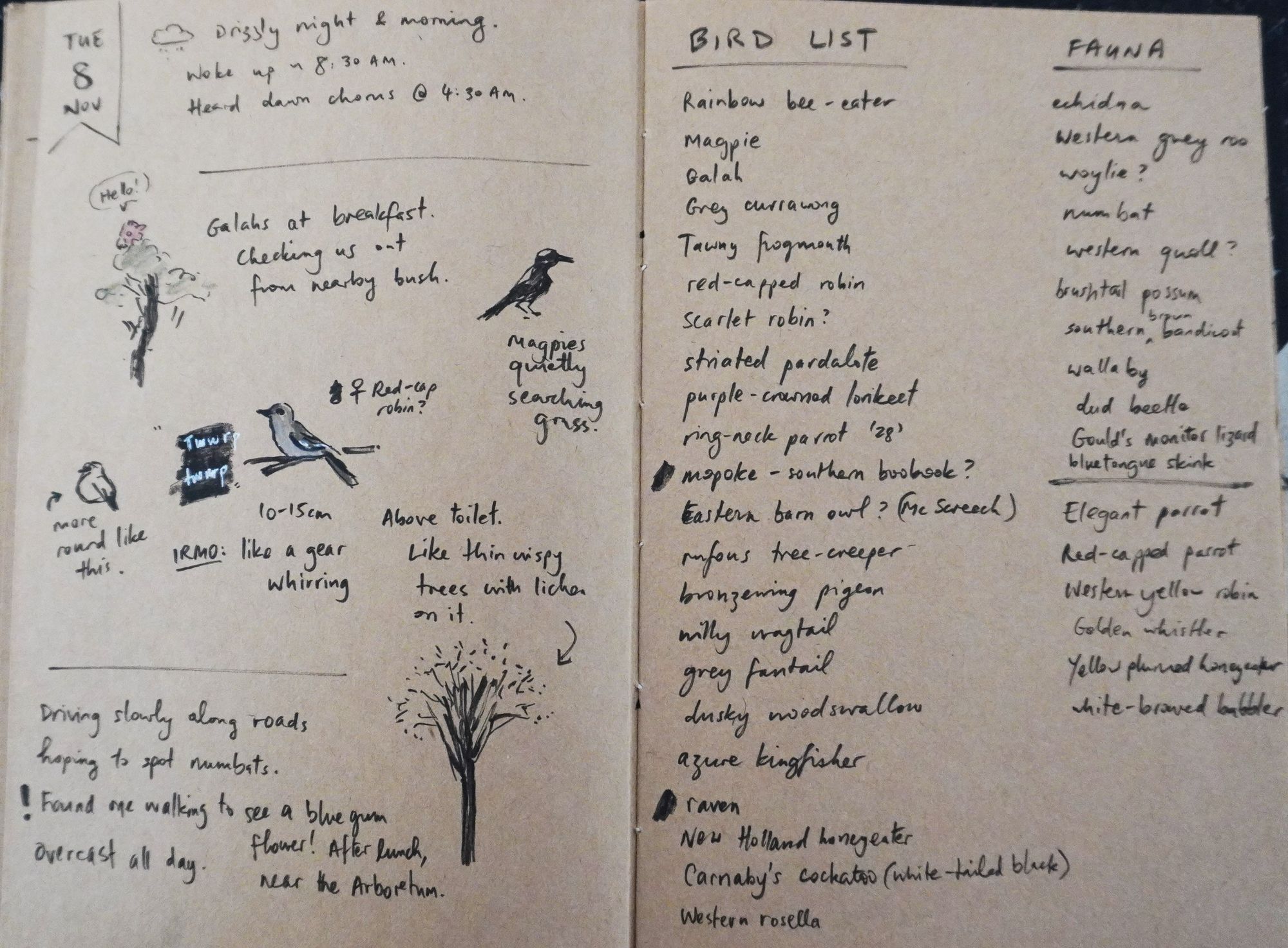
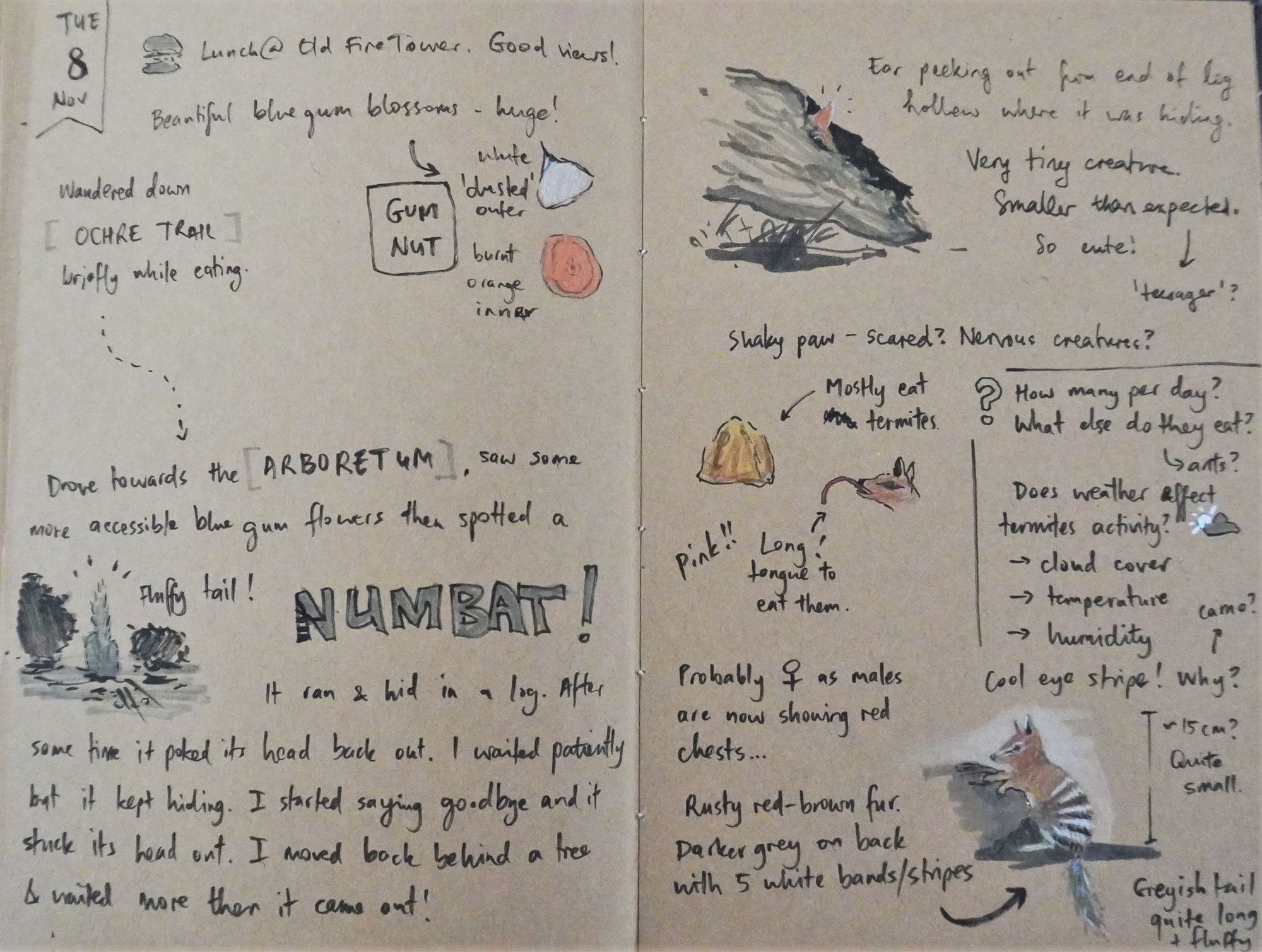
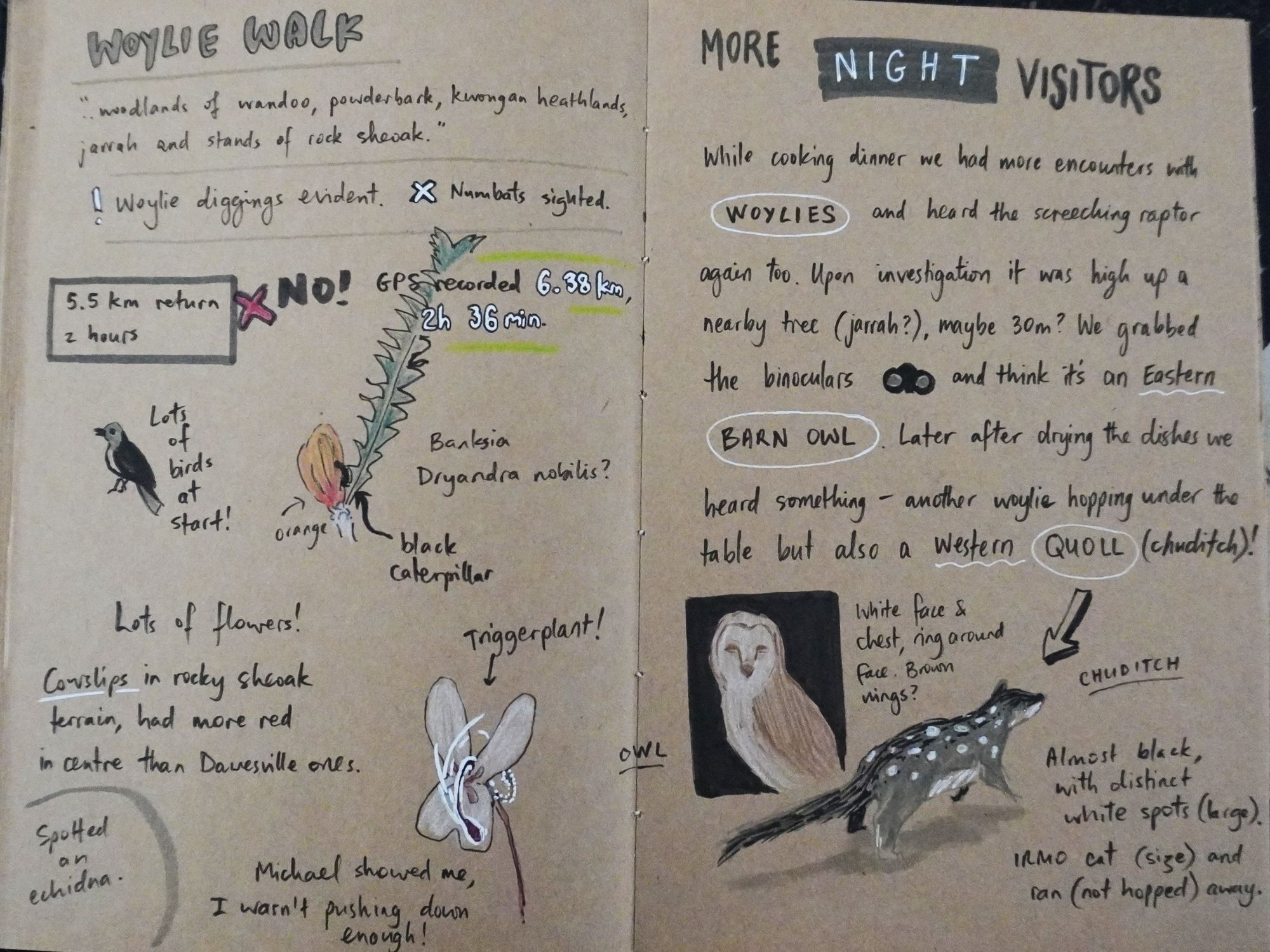
Wednesday 9th November
Darwinia Drive Trail and Wandoo Night walk
We enjoyed a cooked breakfast before embarking on the Darwinia Drive trail. Once again we were lucky to spot a numbat right beside the road on a log - this time a male displaying a red chest. This is due to secretion from a gland that not only stains the fur but also smells attractively to the ladies! He bolted off pretty quickly into the distance so we continued the drive. Later we spotted our first reptile - on one stretch of road adjacent to farmland a large monitor lizard (Gould's perhaps) was crossing the road, so we encouraged it back toward the bush.
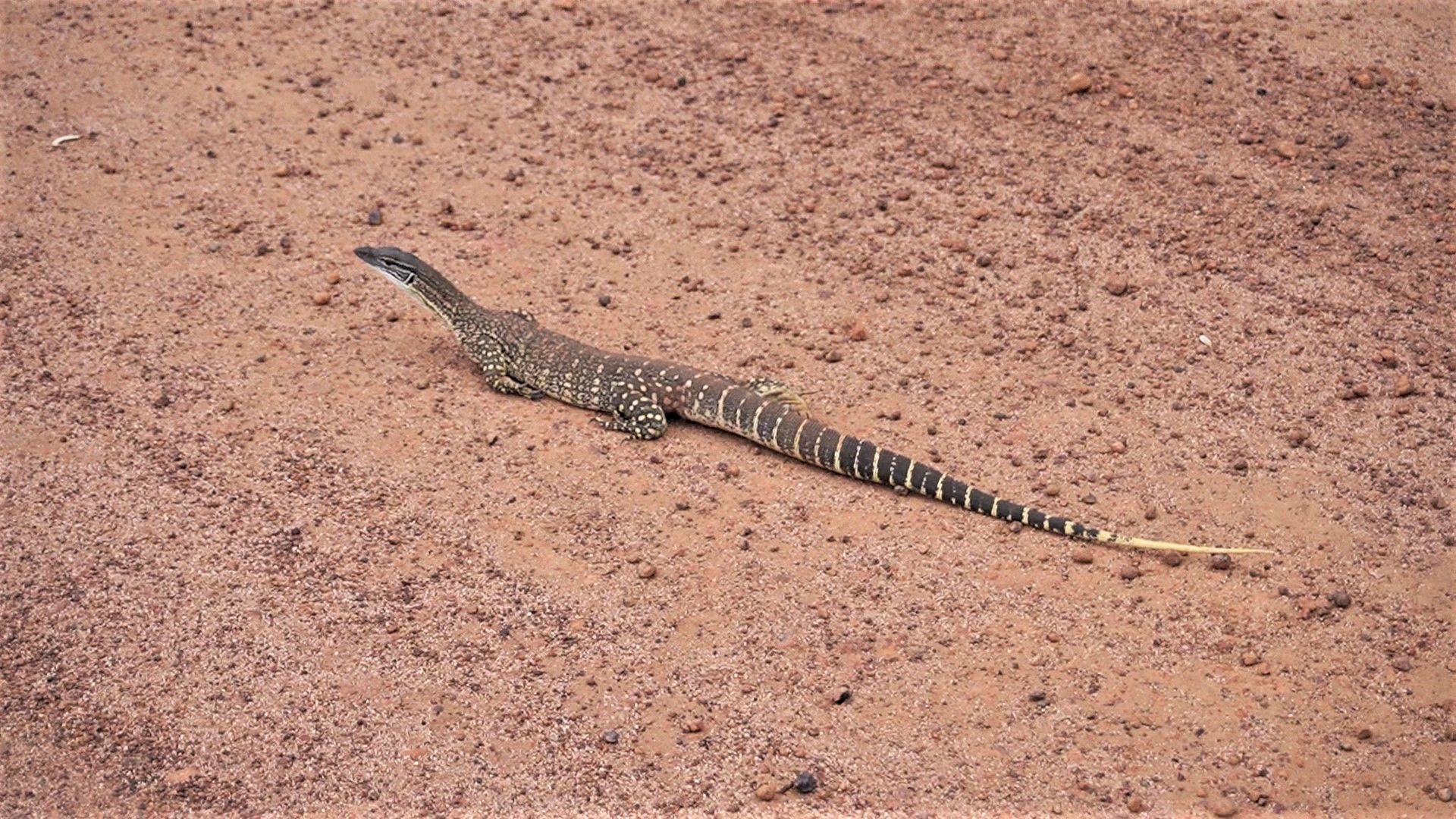
There are five signs along the route with pullover bays, that provided a lot of information about the importance of the different fauna and flora and how they co-habited to create this special ecosystem. One such relationship is with the hemiparasitic sandalwood and woylies that eat the seeds and cache them.


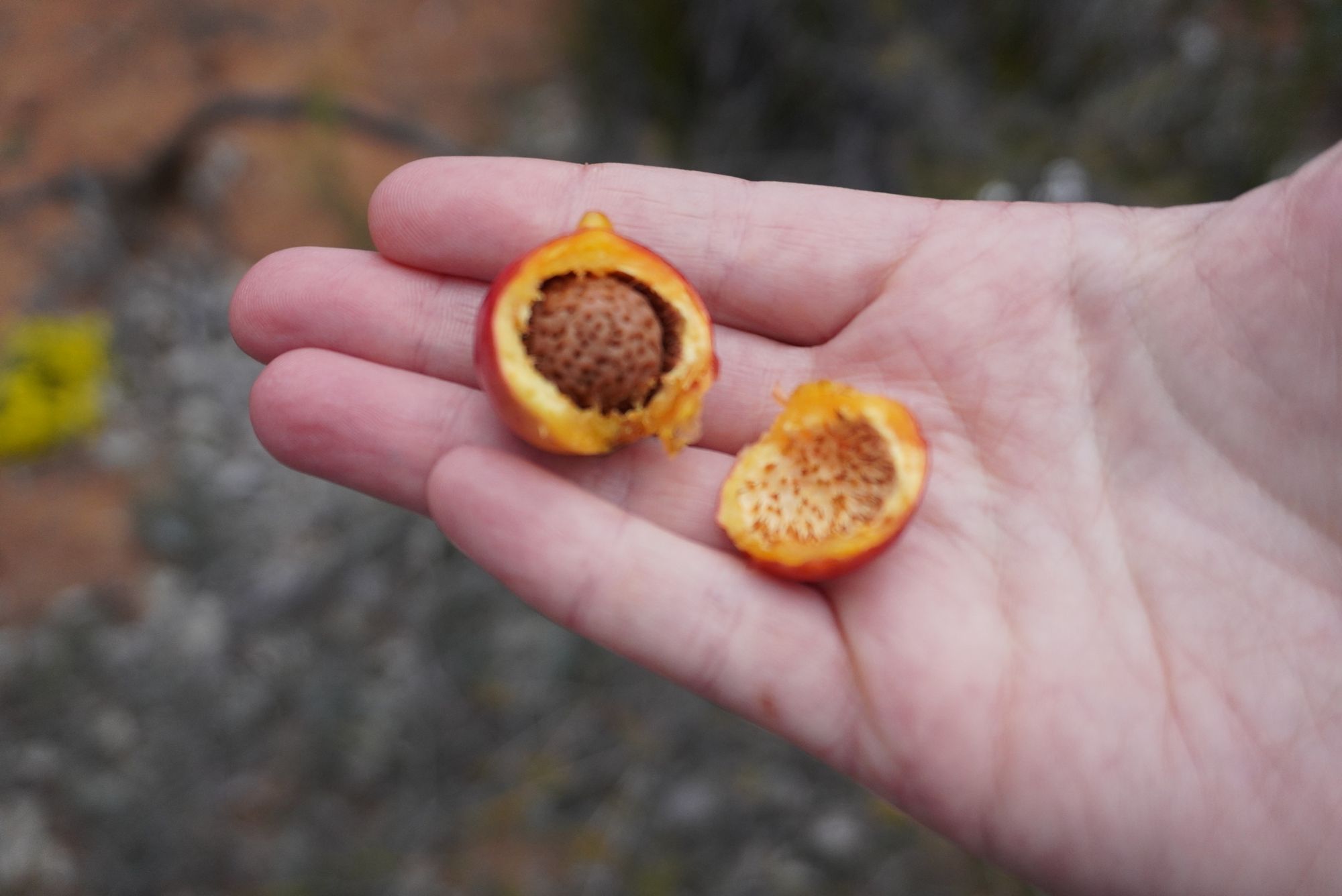
Wandoo woodland such as the one in Dryandra has the highest concentration of termites in the southwest of Western Australia. They are important decomposers in this dry environment, recycling nutrients and forming soil. These woodlands are therefore a favourable habitat for those creatures who depend on a termite diet, such as the turtle frog and numbat. It also explains why numbats are diurnal (most marsupials are nocturnal) as they need to feed during warm, daylight hours when termites are active.
We decided to tackle the Wandoo Night walk that evening (due to missing out on the Barna Mia experience), so stopped at Narrogin for lunch and to buy spare batteries for our headlamps. On the way back we gazed out over the neighbouring farmland from Contine Hill, also part of the woodland. It's a magnificent lookout, with a fire pit that would be cozy to sit by as the sun sets. However our plans that evening were already made, so we headed back.
The Wando Night walk starts from the same place as the Woylie Walk, at the Old Mill Dam picnic area. Sunset was at 6:43 PM and moon rise at 7:41 PM so we arrived at 7:30 PM, with plans to eat dinner after the "short 1 km walk". Once again, the signs were deceptive, as we recorded 2.75 km and it took 1 hour and 45 minutes instead of the 30 minutes advertised! And no - we didn't get lost, but were happy to wander away from the path if something caught our eye, and walked slowly to avoid startling anything.
There was lots to hear and see; kangaroos grazing at the start, possums in the trees, woylies hopping about in the bush. The Australian boobook and Eastern Barn owls cried out and we even found a quenda. With rumbling stomachs we drove slowly back, luckily spotting another quoll in the headlights to top off the evening.
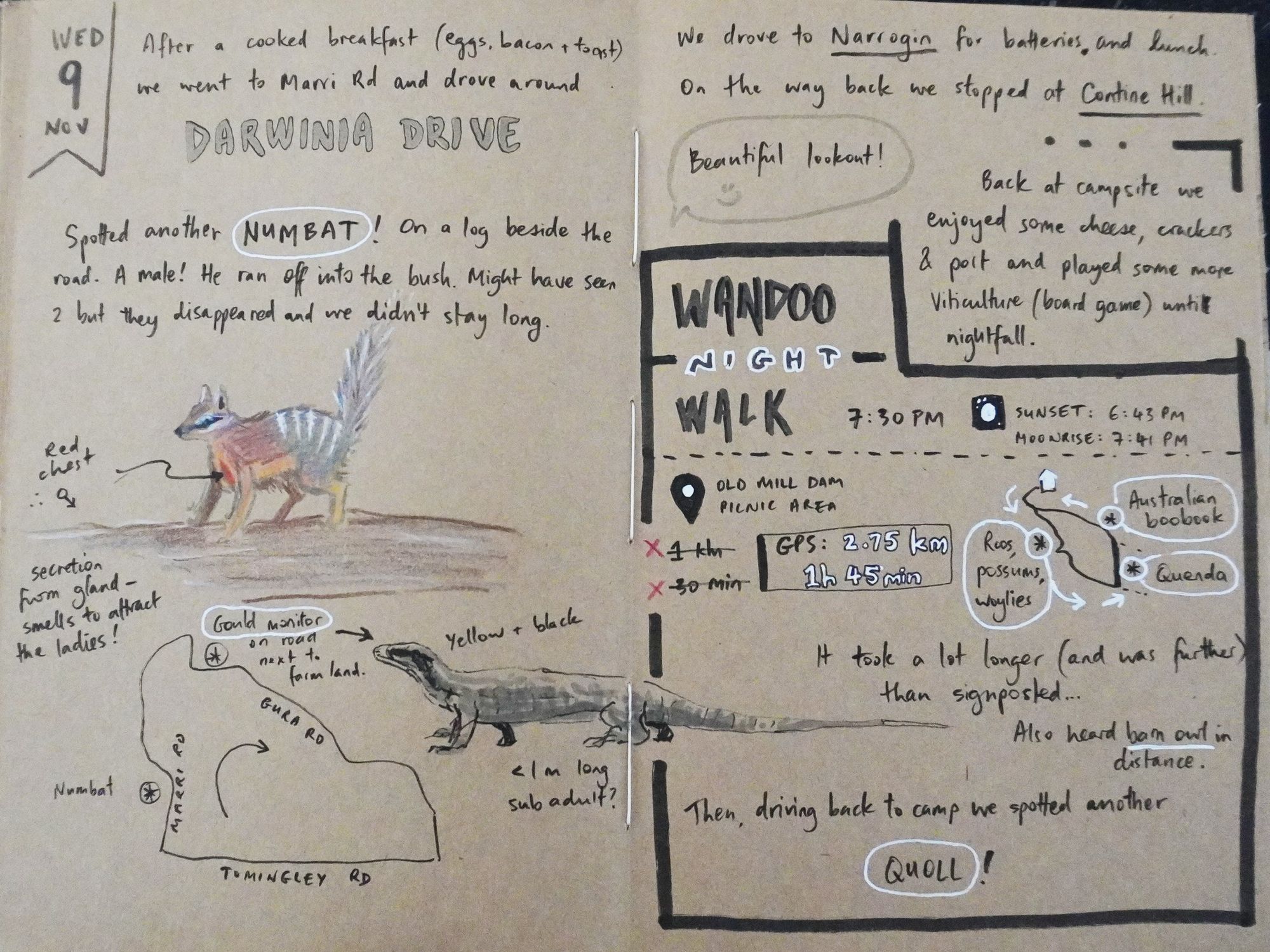
Thursday 10th November
Farewell!
Our final day was not very exciting, although we drove slowly through the drizzle still hoping to spot just one more numbat. At least the numerous birds kept us entertained through our binoculars and we had an echidna farewell us.
We left Dryandra Woodland keen to return soon to try out the other walks and spot more wildlife, as well as the Barna Mia experience. As always, camping under the stars amongst the native wildlife and away from civilisation left us peaceful yet yearning for more.

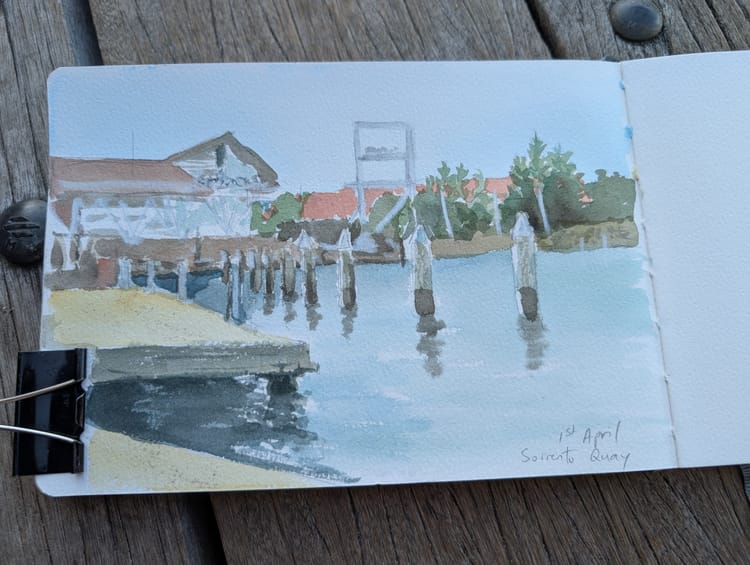
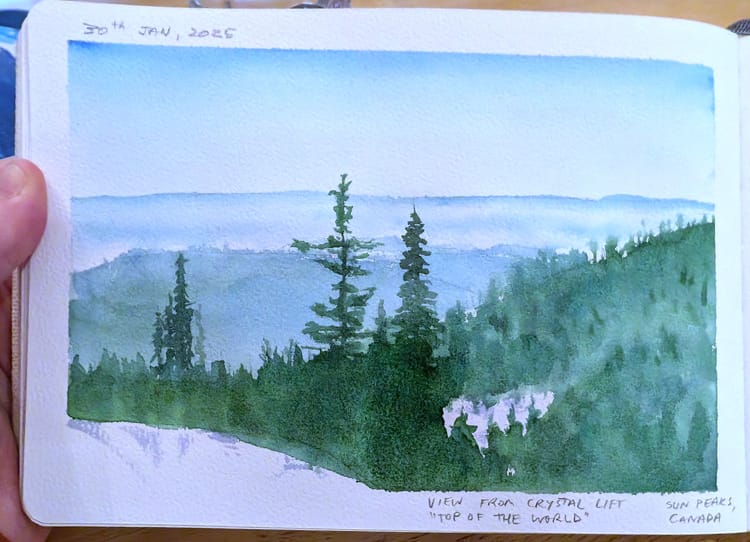

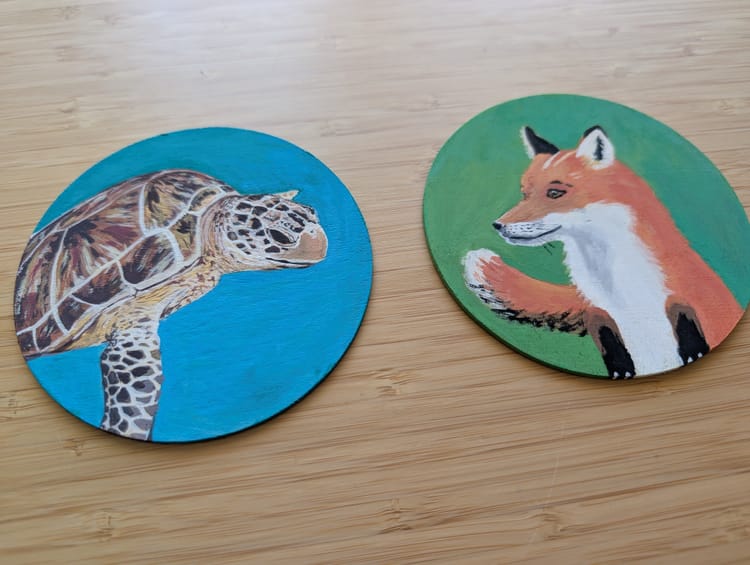
Member discussion